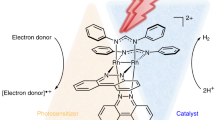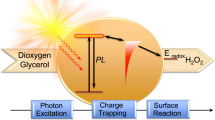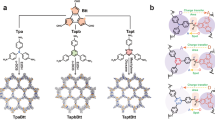Abstract
Hydrogen peroxide (H2O2) is an important industrial chemical and also a possible energy carrier. Photocatalytic synthesis of H2O2 is an attractive alternative to the anthraquinone process, but current catalyst systems suffer from many problems including: a limited sunlight wavelength response, the need for sacrificial reagents and insufficient activity. Here we report self-assembled tetrakis(4-carboxyphenyl)porphyrin supramolecular photocatalysts that produce H2O2 from only H2O and O2 and with a quantum efficiency of 14.9% at 420 nm and 1.1% at 940 nm. The catalyst achieves a solar-to-chemical conversion efficiency of 1.2% at 328 K when irradiated and heated with simulated sunlight. Our results suggest that photogenerated electrons and holes contribute to H2O2 production by reacting on different active sites including pyrrole N–H ring and carboxyl groups. In particular, we propose a hole-induced H2O2 production process, which involves the photoconversion of -COOH to -CO3H groups on the catalyst, followed by thermal decomposition.
This is a preview of subscription content, access via your institution
Access options
Access Nature and 54 other Nature Portfolio journals
Get Nature+, our best-value online-access subscription
$29.99 / 30 days
cancel any time
Subscribe to this journal
Receive 12 digital issues and online access to articles
$119.00 per year
only $9.92 per issue
Buy this article
- Purchase on Springer Link
- Instant access to full article PDF
Prices may be subject to local taxes which are calculated during checkout





Similar content being viewed by others
Data availability
The authors declare that all data supporting the findings of this study are available within the paper and Supplementary Information files. Source data are provided with this paper.
References
Campos-Martin, J. M., Blanco-Brieva, G. & Fierro, J. L. Hydrogen peroxide synthesis: an outlook beyond the anthraquinone process. Angew. Chem. Int. Ed. 45, 6962–6984 (2006).
Wang, N., Ma, S., Zuo, P., Duan, J. & Hou, B. Recent progress of electrochemical production of hydrogen peroxide by two-electron oxygen reduction reaction. Adv. Sci. 8, e2100076 (2021).
Chen, Q. Development of an anthraquinone process for the production of hydrogen peroxide in a trickle bed reactor—from bench scale to industrial scale. Chem. Eng. Process. 47, 787–792 (2008).
Hou, H., Zeng, X. & Zhang, X. Production of hydrogen peroxide by photocatalytic processes. Angew. Chem. Int. Ed. 59, 17356–17376 (2020).
Kofuji, Y. et al. Carbon nitride–aromatic diimide–graphene nanohybrids: metal-free photocatalysts for solar-to-hydrogen peroxide energy conversion with 0.2% efficiency. J. Am. Chem. Soc. 138, 10019–10025 (2016).
Shiraishi, Y. et al. Resorcinol–formaldehyde resins as metal-free semiconductor photocatalysts for solar-to-hydrogen peroxide energy conversion. Nat. Mater. 18, 985–993 (2019).
Ma, R. et al. Solid acids accelerate the photocatalytic hydrogen peroxide synthesis over a hybrid catalyst of titania nanotube with carbon dot. Appl. Catal. B 244, 594–603 (2019).
Teng, Z. et al. Atomically dispersed antimony on carbon nitride for the artificial photosynthesis of hydrogen peroxide. Nat. Catal. 4, 374–384 (2021).
Smith, P. T., Kim, Y., Benke, B. P., Kim, K. & Chang, C. J. Supramolecular tuning enables selective oxygen reduction catalyzed by cobalt porphyrins for direct electrosynthesis of hydrogen peroxide. Angew. Chem. Int. Ed. 59, 4902–4907 (2020).
Feng, D. et al. Zirconium-metalloporphyrin PCN-222: mesoporous metal-organic frameworks with ultrahigh stability as biomimetic catalysts. Angew. Chem. Int. Ed. 124, 10453–10456 (2012).
Kuttassery, F. et al. Water splitting on aluminum porphyrins to form hydrogen and hydrogen peroxide by one photon of visible light. ACS Appl. Energy Mater. 2, 8045–8051 (2019).
Apaydin, D. H. et al. Photoelectrocatalytic synthesis of hydrogen peroxide by molecular copper-porphyrin supported on titanium dioxide nanotubes. ChemCatChem 10, 1793–1797 (2018).
Hong, Y. H. et al. Photocatalytic oxygenation reactions with a cobalt porphyrin complex using water as an oxygen source and dioxygen as an oxidant. J. Am. Chem. Soc. 141, 9155–9159 (2019).
Lobanov, A. V., Rubtsova, N. A., Vedeneeva, Y. A. & Komissarov, G. G. Photocatalytic activity of chlorophyll in hydrogen peroxide generation in water. Dokl. Chem. 421, 190–193 (2008).
Komagoe, K. & Katsu, T. Porphyrin-induced photogeneration of hydrogen peroxide determined using the luminol chemiluminescence method in aqueous solution: a structure-activity relationship study related to the aggregation of porphyrin. Anal. Sci. 22, 255–258 (2006).
Thalberg, K. & Lindman, B. Interaction between hyaluronan and cationic surfactants. J. Phys. Chem. C. 93, 1478–1483 (1989).
Cook, L. P., Brewer, G. & Wong-Ng, W. Structural aspects of porphyrins for functional materials applications. Crystals 7, 223 (2017).
Hashimoto, T., Choe, Y. K., Nakano, H. & Hirao, K. Theoretical study of the Q and B bands of free-base, magnesium, and zinc porphyrins, and their derivatives. J. Phys. Chem. A 103, 1894–1904 (1999).
Posligua, V. et al. Band structures of periodic porphyrin nanostructures. J. Phys. Chem. C. 122, 23790–23798 (2018).
Kaiser, C. et al. A universal Urbach rule for disordered organic semiconductors. Nat. Commun. 12, 3988 (2021).
Makuła, P., Pacia, M. & Macyk, W. How to correctly determine the band gap energy of modified semiconductor photocatalysts based on UV–vis spectra. J. Phys. Chem. Lett. 9, 6814–6817 (2018).
Chun, W. J. et al. Conduction and valence band positions of Ta2O5, TaON, and Ta3N5 by UPS and electrochemical methods. J. Phys. Chem. B 107, 1798–1803 (2003).
Liu, J. et al. Metal-free efficient photocatalyst for stable visible water splitting via a two-electron pathway. Science 347, 970–974 (2015).
Brasileiro, L. B. et al. The use of peracids in delignification and cellulose pulp bleaching. Quím Nova 24, 819–829 (2001).
Zhao, X. et al. Preparation of peracetic acid from hydrogen peroxide, part II: Kinetics for spontaneous decomposition of peracetic acid in the liquid phase. J. Mol. Catal. A 284, 58–68 (2008).
Kunigk, L. et al. The influence of temperature and organic matter on the decomposition kinetics of peracetic acid in aqueous solutions. Lat. Am. Appl. Res. 42, 291–297 (2012).
Bilous, T. et al. Electrochemical synthesis of peroxyacetic acid on Pt/PtO and PbO2 anodes. Chem. Chem. Technol. 14, 135–138 (2020).
Moholkar, V. S. et al. Investigations in physical mechanism of the oxidative desulfurization process assisted simultaneously by phase transfer agent and ultrasound. Ultrason. Sonochem. 24, 98–106 (2015).
Zhao, Y. et al. Denitrification utilizing a vaporized enhanced-Fenton reagent: kinetics and feasibility. RSC Adv. 4, 46060–46067 (2014).
Hoffman, A. J., Carraway, E. R. & Hoffmann, M. R. Photocatalytic production of H2O2 and organic peroxides on quantum-sized semiconductor colloids. Environ. Sci. Technol. 28, 776–785 (1994).
Bannister, J. V., Bellavite, P., Serra, M. C., Thornalley, P. J. & Rossi, F. An EPR study of the production of superoxide radicals by neutrophil NADPH oxidase. FEBS Lett. 145, 323–326 (1982).
Jing, J. et al. Construction of interfacial electric field via dual-porphyrin heterostructure boosting photocatalytic hydrogen evolution. Adv. Mater. 34, 2106807 (2021).
da Silva, W. P., Carlos, T. D., Cavallini, G. S. & Pereira, D. H. Peracetic acid: structural elucidation for applications in wastewater treatment. Water Res. 168, 115143 (2020).
Zhao, X., Zhang, T., Zhou, Y. & Liu, D. Preparation of peracetic acid from hydrogen peroxide: part I: kinetics for peracetic acid synthesis and hydrolysis. J. Mol. Catal. A 271, 246–252 (2007).
Smith, L. M., Aitken, H. M. & Coote, M. L. The fate of the peroxyl radical in autoxidation: how does polymer degradation really occur. Acc. Chem. Res. 51, 2006–2013 (2018).
Luukkonen, T. & Pehkonen, S. O. Peracids in water treatment: a critical review. Crit. Rev. Environ. Sci. Technol. 47, 1–39 (2017).
Hisatomi, T., Maeda, K., Takanabe, K., Kubota, J. & Domen, K. Aspects of the water splitting mechanism on (Ga1−xZnx)(N1−xOx) photocatalyst modified with Rh2−yCryO3 cocatalyst. J. Phys. Chem. C. 113, 21458–21466 (2009).
Lee, J. H. et al. High performance H2O2 production achieved by sulfur-doped carbon on CdS photocatalyst via inhibiting reverse H2O2 decomposition. Appl. Catal. B 284, 119690 (2021).
Shirase, S. et al. Cerium(IV) carboxylate photocatalyst for catalytic radical formation from carboxylic acids: decarboxylative oxygenation of aliphatic carboxylic acids and lactonization of aromatic carboxylic acids. J. Am. Chem. Soc. 142, 5668–5675 (2020).
Kofuji, Y. et al. Hydrogen peroxide production on a carbon nitride–boron nitride‐reduced graphene oxide hybrid photocatalyst under visible light. ChemCatChem 10, 2070–2077 (2018).
Li, Y. et al. Photo-charge regulation of metal-free photocatalyst by carbon dots for efficient and stable hydrogen peroxide production. J. Mater. Chem. A 9, 25453–25462 (2021).
Wang, Q. et al. Scalable water splitting on particulate photocatalyst sheets with a solar-to-hydrogen energy conversion efficiency exceeding 1%. Nat. Mater. 15, 611–615 (2016).
Pan, C. & Zhu, Y. New type of BiPO4 oxy-acid salt photocatalyst with high photocatalytic activity on degradation of dye. Environ. Sci. Technol. 44, 5570–5574 (2010).
Pan, C. et al. Efficient and stable H2O2 production from H2O and O2 on BiPO4 photocatalyst. Appl. Catal. B 316, 121675 (2022).
Jia, Y. et al. Improved performance of polysulfone ultrafiltration membrane using TCPP by post-modification method. Membranes 10, 66 (2020).
Webb, M. J. & Bampos, N. Noncovalent interactions in acid–porphyrin complexes. Chem. Sci. 3, 2351–2366 (2012).
Yang, L. et al. Two-channel photocatalytic production of H2O2 over g-C3N4 nanosheets modified with perylene imides. J. Catal. 352, 274–281 (2017).
Ansari, M. & Singh, S. P. Viscosities and densities of acetonitrile–water systems at 25 °C. Res. J. Chem. Sci. 12, 67–69 (2022).
da Costa, V. C. P. et al. Mutual and self-diffusion of charged porphyrines in aqueous solutions. J. Chem. Thermodyn. 47, 312–319 (2012).
Saiki, H., Takami, K. & Tominaga, T. Diffusion of porphyrins and quinones in organic solvents. Phys. Chem. Chem. Phys. 1, 303–306 (1999).
Acknowledgements
C.P. acknowledges financial support from the National Natural Science Foundation of China (22172065) and Natural Science Foundation of Jiangsu Province (BK20201345). Ying Zhang and Y.D. acknowledge financial support from the Key Program of the National Natural Science Foundation of China (22136002). J.X. acknowledges financial support from the Natural Science Foundation of Jiangsu Province (BK20221541). Y.L. acknowledges financial support from the the National Key R&D Program of China (2021YFB3501900) and Natural Science Foundation of Jiangsu Province (BK20211239). Y. Zhu acknowledges financial support from the National Natural Science Foundation of China (21902009). We would also like to thank W. Wang from Shiyanjia Lab (www.shiyanjia.com) for the UPS analysis.
Author information
Authors and Affiliations
Contributions
C.P. conceived the idea. Yaning Zhang conducted performance evaluation and designed the isotopic experiments. G.B. and Ying Zhang conducted the fabrication experiments. J.X., Y.D., Y.L. and W.L. participated in the paper discussions. C.P. and Y. Zhu planned the research and wrote the paper. All the authors revised and approved the manuscript.
Corresponding authors
Ethics declarations
Competing interests
The authors declare no competing interests.
Peer review
Peer review information
Nature Energy thanks the anonymous reviewers for their contribution to the peer review of this work.
Additional information
Publisher’s note Springer Nature remains neutral with regard to jurisdictional claims in published maps and institutional affiliations.
Supplementary information
Supplementary Information
Supplementary Figs. 1–44, Tables 1–9 and Note 1.
Supplementary Data 1
Statistical source data for Supplementary Figs. 14, 25, 30, 33, 37, 39 and 41a.
Source data
Source Data Fig. 3a
Statistical source data.
Source Data Fig. 4
Statistical source data.
Source Data Fig. 5c
Statistical source data.
Rights and permissions
Springer Nature or its licensor (e.g. a society or other partner) holds exclusive rights to this article under a publishing agreement with the author(s) or other rightsholder(s); author self-archiving of the accepted manuscript version of this article is solely governed by the terms of such publishing agreement and applicable law.
About this article
Cite this article
Zhang, Y., Pan, C., Bian, G. et al. H2O2 generation from O2 and H2O on a near-infrared absorbing porphyrin supramolecular photocatalyst. Nat Energy 8, 361–371 (2023). https://doi.org/10.1038/s41560-023-01218-7
Received:
Accepted:
Published:
Issue Date:
DOI: https://doi.org/10.1038/s41560-023-01218-7
This article is cited by
-
Accelerated discovery of molecular nanojunction photocatalysts for hydrogen evolution by using automated screening and flow synthesis
Nature Synthesis (2024)
-
Enhancing photocatalytic H2O2 production with Au co-catalysts through electronic structure modification
Nature Communications (2024)
-
Keto-anthraquinone covalent organic framework for H2O2 photosynthesis with oxygen and alkaline water
Nature Communications (2024)
-
Linkage-engineered donor–acceptor covalent organic frameworks for optimal photosynthesis of hydrogen peroxide from water and air
Nature Catalysis (2024)
-
A Novel Dual-Channel Carbon Nitride Homojunction with Nanofibrous Carbon for Significantly Boosting Photocatalytic Hydrogen Peroxide Production
Advanced Fiber Materials (2024)



